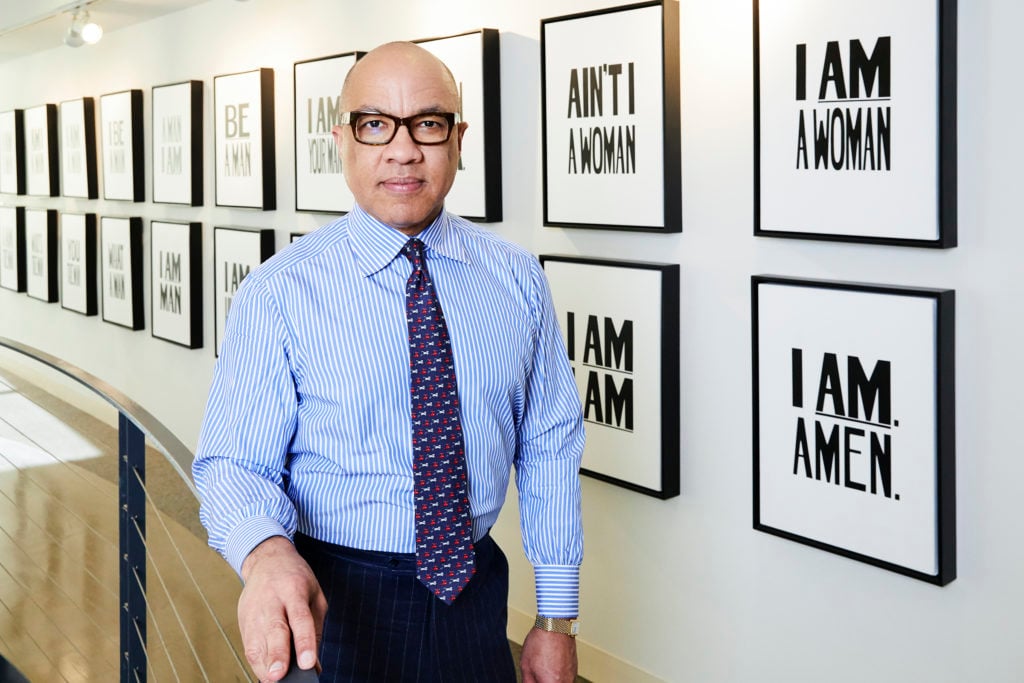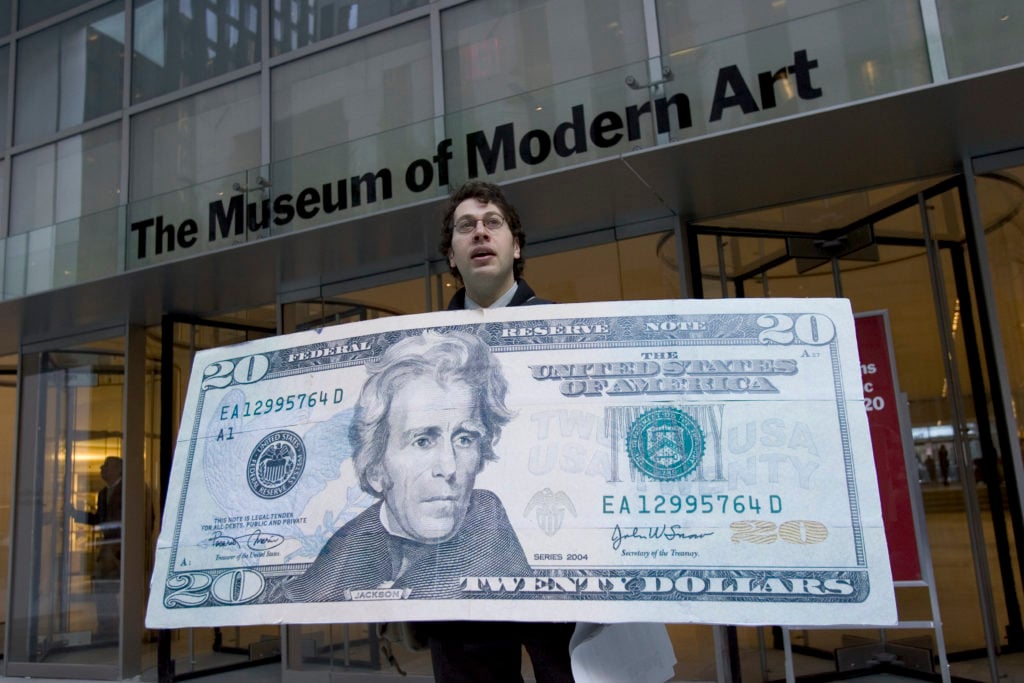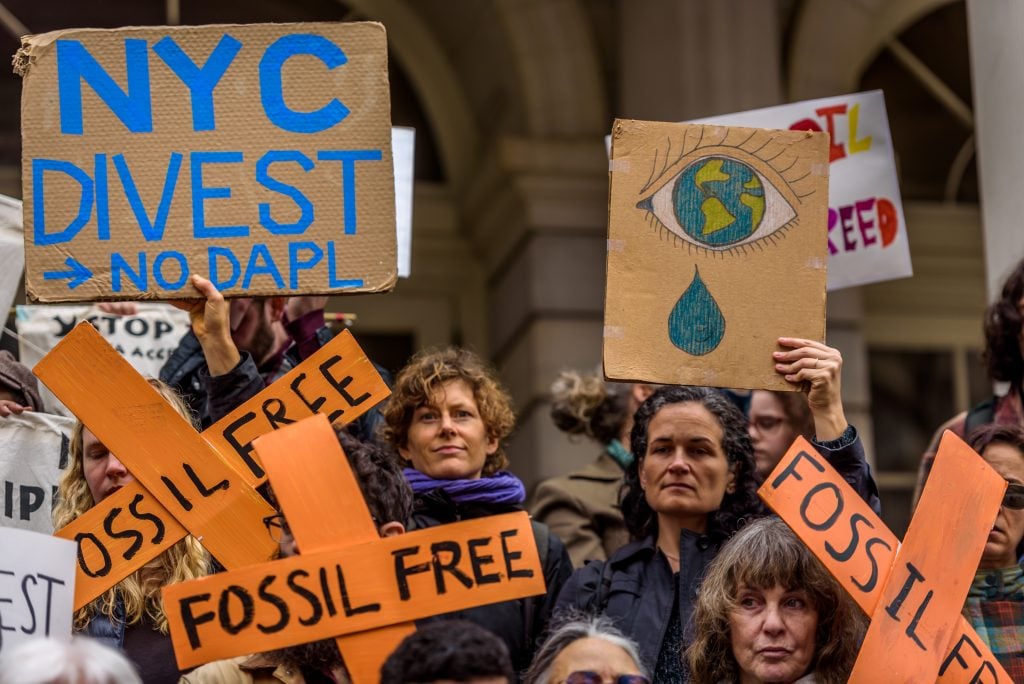Every Wednesday morning, Artnet News brings you The Gray Market. The column decodes important stories from the previous week—and offers unparalleled insight into the inner workings of the art industry in the process.
This week, another case of the right thing being harder to do than it should be…
GOING, GOING, GONE?
Last Monday, one of the world’s largest and most powerful charitable foundations made a move that could send shockwaves through the art world. In an essay titled “Aligning Our Investments and Our Values,” Ford Foundation president Darren Walker announced that “going forward, the foundation’s endowment”—currently valued at $16 billion—“will not invest in any fossil-fuel-related industries.” He added that the foundation would also “look for opportunities to invest in enterprises and funds that are fueling new technologies and capabilities” contributing to a robust and diverse renewable energy sector.
But while Walker’s statement sounded to some ears like an earthshaking pledge to immediately divest from climate-damaging portfolio positions, the reality is different. As a result, the impact of the organization’s more measured strategy may prove to be largely symbolic even in a philanthropic sector where the Ford Foundation plays an enormous role in shaping the topography. In fact, the greatest value of the announcement may be that its limitations offer a teachable moment that can help U.S. art institutions and cultural foundations do even better.
Institutional momentum has been building toward divesting from fossil fuel assets for years. Some major American philanthropic organizations, led by the Wallace Global Fund and the Rockefeller Brothers Fund (both thanked for their counsel by Walker in last week’s statement), first began reorienting their portfolio strategies around eco-consciousness almost two decades ago, as Inside Philanthropy detailed in 2019.
This fall has seen its own surge toward greening gargantuan nonprofit investments. Harvard University (which has a $53.2 billion endowment) declared on September 10 that it would not make future investments in fossil fuel companies, and the MacArthur Foundation (with an $8.2 billion endowment) announced an even more aggressive approach on September 22. I’m sure the Ford Foundation was already deep into due diligence on its own fossil fuel pivot when these two earlier moves went public, but I also think it’s fair to suggest that none of the three foundations made its choice in a sensory-deprivation chamber.
It seems Ford’s announcement was at least partly designed to push more nonprofits of varying sizes to reassess their endowments through a climate-first lens. When I reached out to ask if the organization intended to influence other foundations and institutions (particularly in the arts), a Ford Foundation spokesperson offered a statement that ended as follows: “The decision to turn away from direct investment in fossil fuels is long overdue, and we certainly hope that others will join us.”
Yet conversations with activists, as well as a more meticulous look at Walker’s statement, leave me feeling like the Ford Foundation’s pledge represents more of a half-measure than a full embrace of eco-conscious asset management. Ironically, the less closely other nonprofits read his actual words, the more meaningful action they might be inclined to take as a result of them.

Darren Walker, president of the Ford Foundation. Courtesy of the Ford Foundation.
WHAT DOES “DIVEST” MEAN, ANYWAY?
Saying I spend more time parsing words at a granular level than the average news consumer is a little like saying that Prince wore more purple than the average American man—meaning, an understatement so extreme that it threatens to distort the importance of the thing in question.
At the same time, there are situations where getting a clear view of an issue demands analyzing the exact verbiage used to communicate it. Divestment is one of them. I think it’s fair to say that in everyday conversation, the term is understood to mean the immediate and total sale of a particular investment asset. However, to grasp where we are in the broader movement toward art-world divestment from fossil fuels (let alone portfolio positions that are inequitable in other ways), it’s crucial to begin by recognizing the limits of the Ford Foundation’s own strategy.
Headlines about the story (including at many major media outlets) tended to frame the Ford pledge as a vow to divest from fossil fuel interests. Yet the word “divest” appears only once in Walker’s essay—in a sentence written from the perspective of critics who think the actual steps he announced are insufficient: “If climate catastrophe is so dangerous, one might ask, why won’t you just divest all of your fossil fuel-related assets right now?” In other words, Walker explicitly signals that the foundation is not getting rid of its fossil fuel investments immediately.
What is it doing, then? Strip away the rhetoric and admirable ideals in the essay—Walker is a really good writer!—and what we’re left with is the two-pronged vow I mentioned in my opening paragraph: first, to refrain from making further direct investments in fossil fuels; and second, to search out new investments that could help supercharge a green-energy transition. For now, that’s it.

Jenny Kendler and Jeremy Bolen, Lounging Through the Flood (2019). Courtesy of the artists.
In this sense, the Ford Foundation’s pledge qualifies as more of a refinement of its longtime investing strategy than a hard left turn into something new. (Incidentally, the same is basically true of Harvard’s recent announcement, which an essay in the university’s magazine argued is largely old news wrapped in fresh packaging.) The Ford Foundation has been funding sustainable-energy initiatives “for years,” according to its spokesperson, presumably in part through some of the $1 billion the foundation committed to phase in for “mission-related investments” over a decade-long period starting in 2017.
And again, it is not prioritizing a sell-off of the endowment’s existing fossil fuel assets right away. Instead, Walker takes pains in his statement to downplay those assets as small and therefore relatively insignificant. He notes in the essay that only 0.3 percent of the endowment is “directly invested in fossil fuel companies,” an allocation that he later states “has not increased since 2017.”
The Associated Press reported that another endowment nugget of less than three percent remains invested in private equity funds with fossil fuel holdings, which “will end as these partnerships are liquidated,” according to the foundation. In other words, it was always the plan that Ford’s private-equity investments would be sold during the natural pursuit of optimized investment returns—and the plan has not changed.
This sounds like no big deal when the foundation’s fossil fuel interests are communicated in percentages, but I think the conversation changes somewhat if we instead convert those percentages into approximate dollar values. Based on Ford’s $16 billion endowment, the 0.3 percent still directly invested in fossil fuel companies equates to about $48 million, and the “less than three percent” still invested in private equity funds with fossil fuel holdings equates to somewhere south of $480 million. The latter figure in particular is larger than many nonprofits’ entire portfolios; for example, in fiscal year 2018, the Solomon R. Guggenheim Museum’s endowment totaled a bit less than $86 million.
Further, Walker declares in the essay that the foundation will not exit any of its carbon-based energy investments (whether the direct ones or the indirect ones) at a financial loss since doing so would only weaken the foundation’s grant-making muscle. The implication here is that the Ford Foundation believes it can maximize its ability to effect positive change by maximizing its giving to ethical causes, including renewable energy and ecological sustainability.
As a result, the question of whether or not to divest from its fossil fuel assets must yield to the question of whether or not divestment and subsequent reinvestment would be likely to hurt its bottom line. Since the foundation and its investment advisors deemed the endowment would indeed suffer if it divested now, Walker argues that he and his colleagues have a fiduciary responsibility to wait. He paints this decision as a rejection of “the zero-sum thinking that our approach needs to be all or nothing, immediately or never.”
Walker was right to anticipate that the foundation’s announcement would provoke criticism from elsewhere in the climate- and social-justice realm. Whether or not the strategy stands up to those criticisms is another matter, especially when trying to project how much impact Ford’s choices will have on the investment decisions of other nonprofits inside and outside the cultural sector.

Some artists are doing their best to disentangle themselves from collectors they deem politically inadequate. Photo by James Leynse/Corbis via Getty Images.
HOW MUCH IS ENOUGH?
Here’s the good news: My reporting found a relatively broad consensus that the Ford Foundation’s announcement is likely to inspire some amount of more environmentally engaged action in the institutional realm. It’s just that the people I spoke to also generally agreed the foundation could have done so much more.
Jenny Kendler, an environmentally engaged artist and activist, at first called the organization’s announcement “significant,” though with a heavy asterisk. “I appreciate that Darren Walker is willing to take a position on this,” she said. “We just need to also hold the Ford Foundation accountable to do better. It’s not quite what I wished they were doing, but it’s better than nothing.”
Kendler’s investment in climate justice extends well beyond the studio. She is a member of the fundraising committee of the board of 350.org, a prominent coalition of activist groups working to fast-track the global transition to renewable energy, as well as an organizer with Artists Commit, an initiative to decarbonize the art world.
The longer our conversation went on, however, the more her assessment of the Ford Foundation’s strategy deteriorated. “The position they’ve taken is totally out of alignment with the rest of [Walker’s] statement,” she said. “Why is fiduciary responsibility a higher responsibility than perpetuating the global good?”
“I’d like to see them have the moral courage and moral leadership to say: ‘We’re willing to lose money on this, and we’re willing to spend even more money on this.’ I think that would be more powerful in terms of setting an example for smaller foundations.”
Yet part of Kendler’s frustration stemmed from what she saw as a false binary in Walker’s argument: either immediately divest from fossil fuel assets and sacrifice money that could otherwise be used for grant-making, or hold onto fossil fuel assets and maximize grant-making resources. Multiple knowledgeable Wall Street professionals I spoke to supported her skepticism, as does a growing body of market data.
Perhaps most notably, BlackRock leader Larry Fink doubled down on his call to continue the massive capital reallocation toward ecological sustainability in his annual letter to CEOs this January, partly because “climate risk is investment risk.” In September 2019, the University of California’s investment manager and chairman cowrote an op-ed on their decision to divest the institution’s endowment from fossil fuels strictly for fiduciary reasons. A year earlier, investor and environmental activist Jeremy Grantham published a study (under the cheeky rubric “The Mythical Peril of Divesting From Fossil Fuels”) that found divestment from any one of 10 major sectors in the S&P 500 “will have very little effect” on returns based on historical analysis dating back to 1925.

MoMA Divest member Michael Rakowitz’s The invisible enemy should not exist (Room G, Panel 22) (2018). Photo courtesy of Jane Lombard.
Another flashpoint in Walker’s essay was his invocation of intersectionality as a defense for the foundation’s chosen strategy on fossil fuels, not a reason to go further. “I believe that the intersecting crises of climate change and inequality threaten to make an outmoded vision of perpetuity, at best, obsolete—and, at worst, destructive,” he wrote. The activist group MoMA Divest (which demands the museum sell off its alleged interests in private prisons, as well as remove Larry Fink from its board) offered a blistering statement on the Ford Foundation’s chosen path that read in part:
“[T]he Ford Foundation still contributes to the destructive climate of our city by supporting jail expansion and defending the billionaire class. Our struggles for climate justice and our struggles against class warfare and race apartheid are interlinked… If Ford wants to join the right side of history, they will support calls for climate justice and prison abolition. Ford should disclose any and all holdings responsible for perpetuating harm, both locally and globally, and work to reparate communities impacted by institutional violence.”
Kendler took a more diplomatic stance. She acknowledged the “extremely difficult moral calculus” of trying to prioritize any one social-justice cause over another, whether in divestment and reinvestment or elsewhere. However, she also described climate change as the “umbrella issue” over all the others, from human health, to migration patterns, to food insecurity, and beyond. If foundations and cultural institutions have to choose only one issue to build their investing strategy around, she said, it should be ecological sustainability.
We’ll have to wait and see how many of those endowed organizations decide they have to make the choice, now that Ford has publicized its version of climate-conscious investing. Ironically, I think the best outcome would be if other nonprofits misinterpreted Walker’s essay in the same way as the newsroom editors who framed their headlines about it around divestment (meaning, immediate divestment) from fossil fuels rather than the more conservative reality.
(In response to the counterarguments above, the Ford Foundation spokesperson referred me back to Walker’s original statement and added the following: “As we’ve shared, we have only 0.3 percent of our endowment in direct investments in companies that explore for or develop reserves of fossil fuels. We will be liquidating any such investments and won’t be making new ones. We have not made any such investments since 2013, and we do not intend to make such investments in the future.”)
There is another column to be written about the institutional hurdles that large museums in particular face if and when they decide to green their endowments. In comparison to foundations like Ford, museums generally have less money, are more public-facing, serve a much broader audience, and have vastly more complex governance dynamics—all of which make divestment a thornier proposition.
But as with all efforts to stave off (or at least minimize) catastrophic climate change, where there’s a will, there’s a way. What remains to be seen is where that will can manifest if some of the best candidates to urgently role-model the way remain content to slow-walk it instead.
[Associated Press]
That’s all for this week. ‘Til next time, remember: the sacrifices we have to endure now to make meaningful change pale in comparison to the sacrifices we will have to endure later if we let things mostly stay the same.










